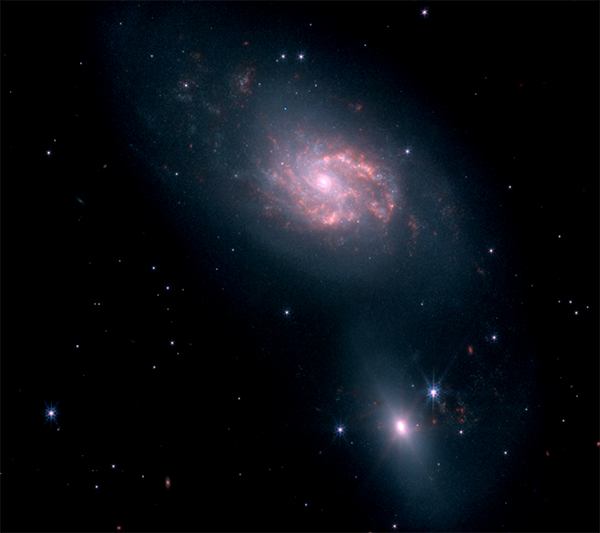For astronomers who have been successful in their bid to lead an observing program on the James Webb Space Telescope, which has been revolutionizing our understanding of the universe since it launched as the latest-and-greatest in infrared astronomy in 2021, it’s an exciting day when the notification comes in that their data is ready to access.
But those astronomers also know to temper their excitement. A lot of work is still needed to process that data so that it’s useful within the scope of their research.

The James Webb Space Telescope continues to revolutionize our understanding of the universe since it launched in 2021, and UToledo’s Department of Physics and Astronomy has seen a wealth of successful proposals for observing programs on the Webb.
At The University of Toledo, 10 physics undergraduate students found themselves uniquely positioned to take on that work under the mentorship of Dr. Rupali Chandar, professor and associate chair of the Department of Physics and Astronomy. In writing a custom reduction and analysis pipeline for James Webb imaging data, they’ve set themselves up for success in graduate school and beyond.
“James Webb data is very precious right now, with a proposal success rate of less than one in 10,” Chandar said. “For our undergraduates, learning to work with this data so early in the mission and their careers is a significant advantage, particularly if they decide to apply for their own observing time when they are in graduate school.”
UToledo’s Department of Physics and Astronomy has seen a wealth of successful proposals for observing programs on the James Webb. Chandar was one of four faculty astronomers and one graduate student who submitted successful proposals in the inaugural cycle, positioning UToledo as No. 6 among institutions worldwide in successful proposals. Chandar was the sole second-cycle observer from UToledo, while two faculty astronomers and Mandy Caputo, a doctoral student who works with Chandar, most recently learned of successful proposals in the highly competitive third cycle in March.
This success has allowed the department to extend an invitation to work with the groundbreaking data not only to graduate students, who traditionally play an integral role in the research ecosystem of astronomy and other scientific disciplines, but also to undergraduate students who have been eager to embrace the opportunity.
“It’s been awesome,” said Tyler Robbins, who just graduated with a bachelor’s degree in physics with a concentration in astrophysics on Saturday, May 4. “I remember watching the James Webb launch on TV, and now here I am actually working on it.”
Chandar connected with the students through a mentoring program established by Dr. Anne Medling, an associate professor in the Department of Physics and Astronomy. The program is in line with Medling’s efforts, supported by her National Science Foundation CAREER Award, to engage the department’s undergraduate students.
When a handful of undergraduate students in Chandar’s “pod” told her they were interested in research, Chandar initially suggested they explore her data on an extreme star-forming galaxy from the Hubble Space Telescope, in anticipation of her second-cycle observing program data looking at the same galaxy with the James Webb.
When the Webb data came in unexpectedly early in October, and with Chandar’s graduate students in the thick of other research projects, these undergraduate researchers were well positioned to shift their focus from Hubble to Webb.
Thomas Behling and Milo Eckhardt joined Robbins as three of the 10 students to take a first look at the new data, which corresponds to images of the targeted galaxy that they described as stunningly crisp in comparison to the Hubble. That’s in part because the James Webb observes in infrared wavelengths, which cut through obscuring dust more effectively.
Behling, Eckhardt and Robbins explained that while processing raw data has become a routine process on older instruments like the Hubble, it presented fresh and interesting challenges with the James Webb.
“Because the James Webb is so new, we’re still figuring out a lot of these processes,” said Behling, who also graduated with a bachelor’s degree in physics with a concentration in astrophysics on May 4. “We’re experimenting and trying to figure it out.”
“It makes for a very unique experience,” added Eckhardt, a rising senior in the same academic program. “It’s been so long since we’ve had a new space telescope that this is the first time that any of us have gotten to see this phase.”
Chandar credited them with writing a custom pipeline that starts from initially detecting sources to measuring their brightnesses in 14 different optical and infrared wavelengths to using these spectral energy distributions to estimate their ages. This pipeline can be used on future datasets of this kind, too — “a huge head start on future research,” she said.
“What the students have accomplished together is very impressive, particularly how they kept asking questions, testing and working through the challenges,” she said.
The students will be co-authors on the research article that results from their efforts.
Behling, Eckhardt and Robbins are interested in careers in research, with Behling preparing to begin graduate school in the fall at Michigan State University and Robbins on track to continue Webb research next year at UToledo before enrolling in graduate school in 2025.
They credit their Webb experience with setting them up for success.
“This is the future of astronomy for at least the next 10, 20 years,” Behling said. “A lot of the upcoming research in this field is going to be based on the James Webb. It’s been great to get experience working with it already.”